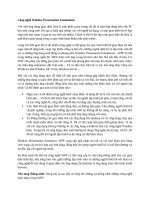princ ch26 presentation
Bạn đang xem bản rút gọn của tài liệu. Xem và tải ngay bản đầy đủ của tài liệu tại đây (1.09 MB, 32 trang )
CHAPTE
R
26
Saving, Investment, and
the Financial System
Economics
N. Gregory
PRINCIPLES OF
Mankiw
Premium PowerPoint Slides
by Ron Cronovich
© 2009 South-Western, a part of Cengage Learning, all rights reserved
In this chapter,
look for the answers to these
questions:
What are the main types of financial institutions in
the U.S. economy, and what is their function?
What are the three kinds of saving?
What’s the difference between saving and
investment?
How does the financial system coordinate saving
and investment?
How do govt policies affect saving, investment, and
the interest rate?
2
Financial Institutions
The financial system: the group of institutions
that helps match the saving of one person with the
investment of another.
Financial markets: institutions through which
savers can directly provide funds to borrowers.
Examples:
The Bond Market.
A bond is a certificate of indebtedness.
The Stock Market.
A stock is a claim to partial ownership in a
firm.
SAVING, INVESTMENT, AND THE FINANCIAL SYSTEM
3
Financial Institutions
Financial intermediaries: institutions through
which savers can indirectly provide funds to
borrowers. Examples:
Banks
Mutual funds – institutions that sell shares to
the public and use the proceeds to buy
portfolios of stocks and bonds
SAVING, INVESTMENT, AND THE FINANCIAL SYSTEM
4
Different Kinds of Saving
Private saving
= The portion of households’ income that is not
used for consumption or paying taxes
=Y–T–C
Public saving
= Tax revenue less government spending
=T–G
SAVING, INVESTMENT, AND THE FINANCIAL SYSTEM
5
National Saving
National saving
= private saving + public saving
=
=
(Y – T – C) +
(T – G)
Y – C – G
= the portion of national income that is not used
for consumption or government purchases
SAVING, INVESTMENT, AND THE FINANCIAL SYSTEM
6
Saving and Investment
Recall the national income accounting identity:
Y = C + I + G + NX
For the rest of this chapter, focus on the closed
economy case:
Y=C+I+G
national saving
Solve for I:
I = Y–C–G
= (Y – T – C) + (T – G)
Saving
Saving == investment
investment in
in aa closed
closed economy
SAVING, INVESTMENT, AND THE FINANCIAL SYSTEM
7
Budget Deficits and
Surpluses
Budget surplus
= an excess of tax revenue over govt spending
= T–G
= public saving
Budget deficit
= a shortfall of tax revenue from govt spending
= G–T
= – (public saving)
SAVING, INVESTMENT, AND THE FINANCIAL SYSTEM
8
ACTIVE LEARNING 1
A. Calculations
Suppose GDP equals $10 trillion,
consumption equals $6.5 trillion,
the government spends $2 trillion
and has a budget deficit of $300 billion.
Find public saving, taxes, private saving,
national saving, and investment.
9
ACTIVE LEARNING 1
Answers, part A
Given:
Y = 10.0,
C = 6.5,
G = 2.0,
G – T = 0.3
Public saving = T – G = – 0.3
Taxes: T = G – 0.3 = 1.7
Private saving = Y – T – C = 10 – 1.7 – 6.5 = 1.8
National saving = Y – C – G = 10 – 6.5 = 2 = 1.5
Investment = national saving = 1.5
10
ACTIVE LEARNING 1
B. How a tax cut affects
saving
Use the numbers from the preceding exercise,
but suppose now that the government cuts taxes
by $200 billion.
In each of the following two scenarios,
determine what happens to public saving,
private saving, national saving, and investment.
1. Consumers save the full proceeds of the
tax cut.
2. Consumers save 1/4 of the tax cut and spend
the other 3/4.
11
ACTIVE LEARNING 1
Answers, part B
In both scenarios, public saving falls by
$200 billion, and the budget deficit rises
from $300 billion to $500 billion.
1. If consumers save the full $200 billion,
national saving is unchanged,
so investment is unchanged.
2. If consumers save $50 billion and spend $150
billion, then national saving and investment
each fall by $150 billion.
12
ACTIVE LEARNING 1
C. Discussion questions
The two scenarios from this exercise were:
1. Consumers save the full proceeds of the
tax cut.
2. Consumers save 1/4 of the tax cut and
spend the other 3/4.
Which of these two scenarios do you think is
more realistic?
Why is this question important?
13
The Meaning of Saving and
Investment
Private saving is the income remaining after
households pay their taxes and pay for
consumption.
Examples of what households do with saving:
Buy corporate bonds or equities
Purchase a certificate of deposit at the bank
Buy shares of a mutual fund
Let accumulate in saving or checking
accounts
SAVING, INVESTMENT, AND THE FINANCIAL SYSTEM
14
The Meaning of Saving and
Investment
Investment is the purchase of new capital.
Examples of investment:
General Motors spends $250 million to build
a new factory in Flint, Michigan.
You buy $5000 worth of computer equipment
for your business.
Your parents spend $300,000 to have a new
house built.
Remember:
Remember: In
In economics,
economics, investment
investment is
is NOT
NOT
the
the purchase
purchase of
of stocks
stocks and
and bonds!
bonds!
SAVING, INVESTMENT, AND THE FINANCIAL SYSTEM
15
The Market for Loanable Funds
A supply-demand model of the financial system
Helps us understand
how the financial system coordinates
saving & investment
how govt policies and other factors affect
saving, investment, the interest rate
SAVING, INVESTMENT, AND THE FINANCIAL SYSTEM
16
The Market for Loanable Funds
Assume: only one financial market
All savers deposit their saving in this market.
All borrowers take out loans from this market.
There is one interest rate, which is both the
return to saving and the cost of borrowing.
SAVING, INVESTMENT, AND THE FINANCIAL SYSTEM
17
The Market for Loanable Funds
The supply of loanable funds comes from saving:
Households with extra income can loan it out
and earn interest.
Public saving, if positive, adds to national saving
and the supply of loanable funds.
If negative, it reduces national saving and the
supply of loanable funds.
SAVING, INVESTMENT, AND THE FINANCIAL SYSTEM
18
The Slope of the Supply
Curve
Interest
Rate
Supply
6%
3%
60
80
An increase in
the interest rate
makes saving
more attractive,
which increases
the quantity of
loanable funds
supplied.
Loanable Funds
($billions)
SAVING, INVESTMENT, AND THE FINANCIAL SYSTEM
19
The Market for Loanable Funds
The demand for loanable funds comes from
investment:
Firms borrow the funds they need to pay for
new equipment, factories, etc.
Households borrow the funds they need to
purchase new houses.
SAVING, INVESTMENT, AND THE FINANCIAL SYSTEM
20
The Slope of the Demand
Curve
A fall in the interest
rate reduces the cost
of borrowing, which
increases the quantity
of loanable funds
demanded.
Interest
Rate
7%
4%
Demand
50
80 Loanable Funds
($billions)
SAVING, INVESTMENT, AND THE FINANCIAL SYSTEM
21
Equilibrium
Interest
Rate
Supply
The interest rate
adjusts to equate
supply and demand.
The eq’m quantity
of L.F. equals
eq’m investment
and eq’m saving.
5%
Demand
60
Loanable Funds
($billions)
SAVING, INVESTMENT, AND THE FINANCIAL SYSTEM
22
Policy 1: Saving Incentives
Interest
Rate
S1
S2
5%
4%
D1
60 70
Tax incentives for
saving increase
the supply of L.F.
…which reduces the
eq’m interest rate
and increases the
eq’m quantity of L.F.
Loanable Funds
($billions)
SAVING, INVESTMENT, AND THE FINANCIAL SYSTEM
23
Policy 2: Investment
Incentives
Interest
Rate
An investment tax
credit increases the
demand for L.F.
S1
6%
5%
D2
…which raises the
eq’m interest rate
and increases the
eq’m quantity of L.F.
D1
60 70
Loanable Funds
($billions)
SAVING, INVESTMENT, AND THE FINANCIAL SYSTEM
24
ACTIVE LEARNING 2
Exercise
Use the loanable funds model to analyze
the effects of a government budget deficit:
Draw the diagram showing the initial
equilibrium.
Determine which curve shifts when the
government runs a budget deficit.
Draw the new curve on your diagram.
What happens to the equilibrium values of the
interest rate and investment?
25









